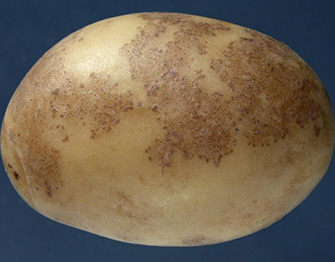Please click here to access the main AHDB website and other sectors.
- Home
- Knowledge library
- Black dot
Black dot

Black dot is caused by the fungus Colletotrichum coccodes and although a mild disease it is one of the most problematic blemish diseases of washed, pre-packed potatoes.
Symptoms
Black dot takes its name from the tiny jet black microsclerotia that are just visible to the naked eye both on the blemish and on stem and stolen lesions late in the season.
Symptoms are usually seen later in the season and are present on stems, stolons and roots, however this does not necessarily lead to tuber disease. Vascular disease can lead to stem girdling and resulting in foliar wilt that can be confused with other wilt diseases. The disease can cause early senescence.
Tuber symptoms are present at harvest. Affected skin initially appears light brown to unblemished, but with dots. Later unsightly dark brown patches can develop. Lesions tend to be irregularly shaped and often without a defined outline. Lesions on red potatoes and well developed lesions can look silvery leading to confusion with silver scurf. The black dots which differentiate this disease from silver scurf are visible with the naked eye and are easily seen under a hand lens (10 x magnification).
Conditions
The disease can be seed borne but more commonly infects tubers from contaminated soil. In store, warm humid conditions favour progression development disease.
Control
Long rotations are advisable as microsclerotia can survive 7 years in soil. Using clean seed will prevent soil contamination. In the interim, control of weed hosts and volunteers is good practice.
Varietal susceptibility varies. Resistance ratings are provided in the Potato Variety Database. See the Independent Variety Trials programme (ended in 2018) page for more information on the test methods used to assess varietal susceptibility.
A fungicidal soil treatment (azoxystrobin) can delay disease development by several weeks.
Wet and warm soil conditions, especially late in the season, will promote the disease (avoid over-irrigation). Crop durations in infected soils of 120 days or less (50 % emergence to harvest) will have less disease than those of longer durations. Rapid pull-down to storage temperature (for example 0.5oC/day with ventilation) inhibits the development of the disease in storage.

